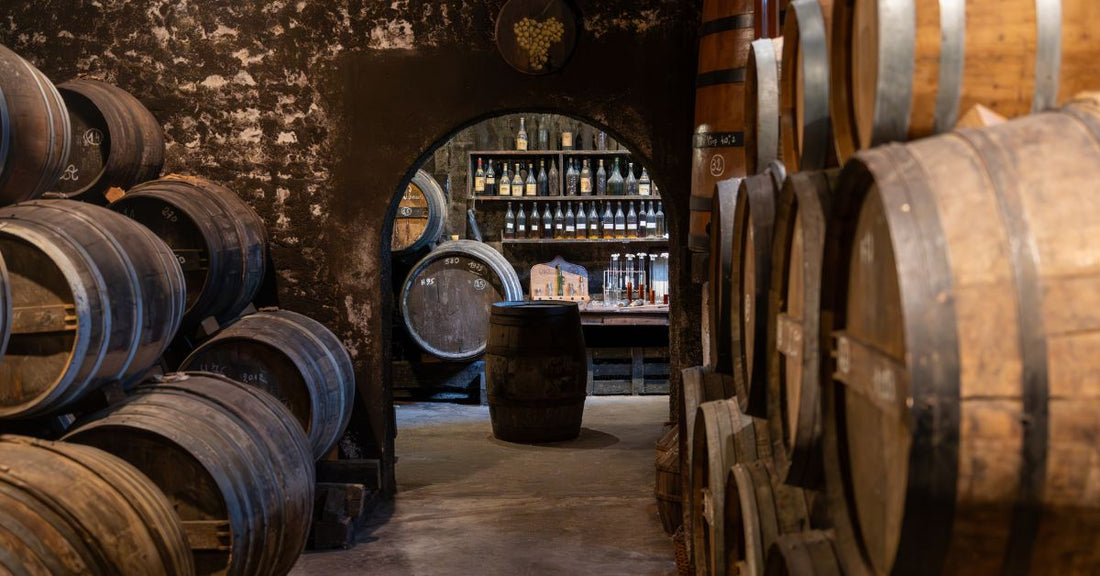Wine aging holds a certain allure to many wine drinkers. The idea of a simple bottle transforming into something extraordinary over years or decades feels almost magical. But behind the mystique lies a fascinating science.
Most wine enthusiasts have a basic idea of the wine brewing and aging process, but do you know what actually happens to wine as it ages? This article demystifies the wine aging process, from the chemical transformations to the factors that influence the process, guiding you to better understand and appreciate the beauty of aged wine.
Why Understanding Wine Aging Matters
Wine aging isn’t always a necessity. In fact, many wines are perfectly enjoyable young. However, for specific varieties, aging unlocks deeper complexities and elevates the tasting experience.
Knowing how wine evolves helps enthusiasts make informed decisions about which wines to cellar, how long to wait, and when a bottle has reached its peak. This knowledge also helps you make intentional and worthwhile investments in notable vintages.
The Science Behind Wine Aging
Understanding the aging process begins with examining the complex interplay of chemical and physical changes in the bottle. Over time, a wine’s composition undergoes subtle yet profound transformations, which reshape its flavor profile, texture, and aromatic complexity.
Central to this is the wine’s interaction with trace amounts of oxygen that eventually penetrate the cork. Tiny amounts of oxygen trigger essential slow-oxidation processes that mellow harsh flavors and contribute to the wine’s complexity. Additionally, aging allows tannins, compounds responsible for astringency, to polymerize, softening the wine’s texture and bringing balance. These slow transformations make aged wine smoother, rounder, and more harmonious.
Key Chemical Reactions in Aging
The aging process involves several chemical reactions that occur within the wine’s unique environment. Oxidation, although minimal, breaks down compounds and allows the wine to mature gracefully. The cork provides just enough oxygen to work its magic without overwhelming the wine.
Polymerization is another critical reaction, in which tannins and anthocyanins (responsible for color) bind together. This process softens the wine and also subtly alters its color, typically shifting reds to deep brick tones and whites to golden hues.
Meanwhile, solvent action involves alcohol dissolving compounds in the wine, releasing a more diverse range of aromas and flavors. These combined reactions are what transform wine from fresh to layered and intricate over time.

The Evolution of Flavor, Texture, and Aroma
One of the most fascinating aspects of aging is how wine’s sensory characteristics develop. Flavors that felt sharp or overpowering in a young wine meld together, creating subtle layers that harmonize on the palate.
For red wines, fruit-forward notes may fade into dried fruit, cedar, or even earthy flavors. White wines often develop richer, nutty profiles with hints of honey or brioche.
Texture also evolves. While young wines tend to feel aggressive due to pronounced tannins, aging typically results in a smoother, velvety mouthfeel thanks to structure-softening effects. Aromatically, aging amplifies secondary and tertiary notes, giving way to exquisite bouquets rarely present in youthful bottles.
Factors That Influence Wine Aging
Not all wines improve with aging, and several factors determine whether a wine is fit for the cellar. First and foremost, storage conditions play a crucial role. Ideal aging occurs in environments with consistent temperatures (usually a standard of 55°F), appropriate humidity, and minimal light exposure. Even minor deviations can accelerate spoilage.
The grape variety and winemaking process are equally important. Notably, wines with strong tannic structures, good acidity, and balanced alcohol content generally age the best. Cabernet Sauvignon and Syrah are classic examples of age-worthy reds, while white varieties such as Riesling and Chardonnay also have cellaring potential.
Winemaking choices such as barrel aging in new oak or limited filtration further enhance a wine’s aging potential. Consider looking for these specialty types of blends at your next wine tasting or vineyard trip.
How to Determine If a Wine Ages Well
Assessing whether a wine is aging well is an essential skill. Start by identifying visual cues—red wines tend to shift from ruby to garnet or brown-red over time. Whites will deepen in color, turning golden or amber. While you can expect these visual changes, they should remain within a spectrum that indicates health rather than spoilage.
The nose can also provide crucial hints. An aged wine’s aroma should be complex and inviting, with no overpowering signs of oxidation or vinegar-like scents.
Finally, tasting the wine reveals its true harmony. Excellent aging strikes a balance between acidity, tannins, and flavor complexity while retaining freshness, even in older bottles.

Wines That Benefit from Extensive Aging
While you should enjoy certain wines fresh, such as some sparkling wines, others require time to reach their best expression. Fine Bordeaux and Burgundy are prime examples of reds built for long-term aging. These wines typically boast robust tannins, ample acidity, and nuanced structures that reward patience.
Among white wines, high-quality Rieslings or even vintage champagnes can dramatically improve with age. Both are bolstered by acidity and sugar levels that preserve their freshness over decades. Knowing which wines are best consumed aged is critical in building an enjoyable and diverse cellar.
The Role of Aged Wines in the Market
Aged wine also holds a significant place in the broader wine market, often commanding premium prices. Collectors and connoisseurs place immense value on rare or perfectly stored vintages from reputable producers, which drives the demand for these bottles. More casual enthusiasts often view obtaining and drinking bottles of aged, vintage wine for special occasions, as their higher price tags allow.
Exploring Aged Wines
Sourcing wines of different ages can enrich your understanding of how they transform. To find well-aged bottles, visit specialty wine shops, such as The Wine Market. Whether you’re looking for new or old bottles, you can find a wide variety of wines at our convenient online shop.
You don’t have to break the bank finding a vintage blend either, we also carry inexpensive red wine brands and more. Browse our curated collection today to find the perfect bottle for your next event.
Discover the Beauty of Aged Wine
Aged wine delivers a specialty drinking experience that young bottles of wine cannot replicate. It refines flavors, enhances textures, and introduces layers of complexity that deepen over time.
Now that you know what happens during the aging process, if you haven’t yet explored aged wine, now is the perfect time to start. Seek out bottles with aging potential or indulge in a ready-to-drink vintage from trusted sources like The Wine Market. The world of aged wine offers endless intrigue and delight for those willing to savor its nuanced charm.

